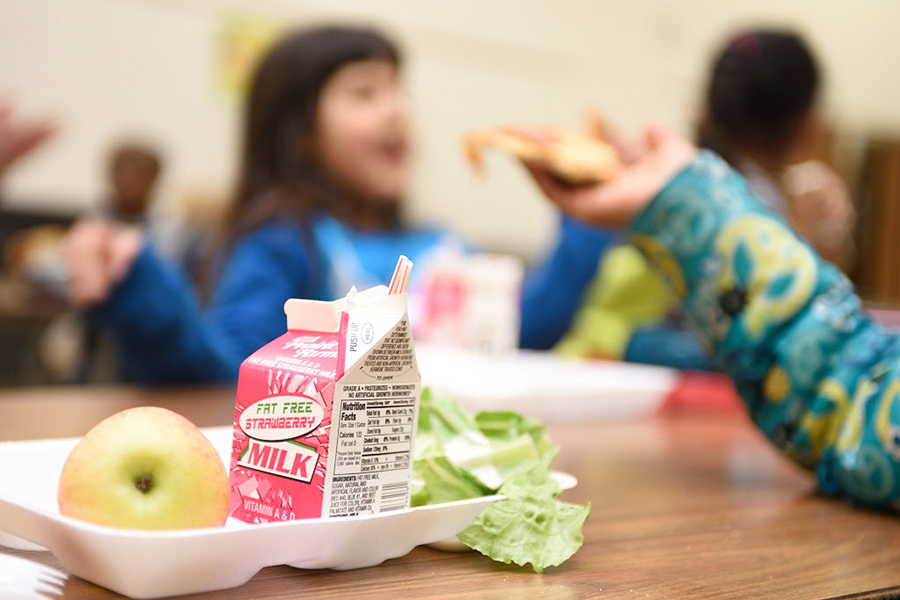When a child has no lunch money, whose problem is it?
Jaynelle Minor remembers the anguish on the faces of the school cafeteria workers. Under district policy, they were required to deny lunch to kids whose parents hadn't paid their school lunch bills.
Ms. Minor, the student nutrition supervisor for New Mexico’s Farmington Municipal School District, also remembers how some of those workers would sneak back into the cafeteria to get fruit or some other snack to stop the children from going hungry. What the kindness of those workers couldn’t stop, however, was a phenomenon known as “lunch shaming” – policies that required lunch workers to single out children whose parents have not paid their lunch fees.
To some observers, lunch shaming is a practice that has spiraled out of control in US public schools.
Some school districts deal with the problem by giving students whose parents have not paid lunch fees a bare-bones cold lunch, such as a sandwich consisting of two pieces of bread and one slice of cheese. But in some other districts, lunch shaming goes further: it may include dumping the hot lunches students had hoped to eat into the trash in front of them, making them do chores to pay off their lunch debt, requiring them to wear wristbands, or sending them home with stamps on their arms saying, “I need lunch money.”
In New Mexico it was Sen. Michael Padilla (D) – who said that as a hungry foster child he had experienced first-hand the pain of lunch shaming – who introduced the Hunger-Free Students’ Bill of Rights. The bill was passed by the New Mexico state legislature last week. Other lawmakers nationwide have reached out to him for guidance on how they can end lunch shaming in their own states, Senator Padilla told NPR.
California and Texas have tabled similar bills, and by July 1, 2017, the US Department of Agriculture (USDA) will require every school district to have a written policy that clearly communicates to staff and parents how schools will deal with children whose parents have not paid their lunch bills.
In New Mexico, says Jennifer Ramo, the executive director of antipoverty group New Mexico Appleseed, politicians on both sides of the aisle were “horrified” by the lunch-shaming practices that have been coming to light.
And it's not just in New Mexico. Stories of lunch-shaming practices have made headlines at a number of schools across the United States. At a public school in Salt Lake City, up to 40 kids with overdue accounts had their meals thrown away in front of them. In the Canon-McMillan school district in Pennsylvania, a cafeteria worker quit her job after she was forced to deny a young boy a hot meal.
School districts have defended such actions by pointing out that unpaid lunch fees are not an insignificant problem. In 2014, data from the School Nutrition Association showed that more than 70 percent of US public school districts had some amount of meal debt, ranging from as little as $2 up to as high as $4.7 million for the largest districts.
Canon-McMillan superintendent Matthew Daniels told Action News 4 WTAE that school policies regarding unpaid lunch fees were simply intended to motivate parents to keep current on their child's lunch tab. Before denying hot lunches to students whose parents had not paid, the district was owed $60,000 and $100,000 by 300 families annually, he said. After adopting the policy, the debt was reduced to a total of $20,000 owed by 70 families.
In theory, there should never be a schoolchild in the US who goes hungry at lunchtime. Government-funded programs like The National Free Lunch Program offer free or reduced-cost lunches to millions of US students each year. But the families of many students who qualify opt not to take advantage of such programs – either because of stigma connected to the program or perhaps lack of understanding about how to connect with it.
Also, school officials say, it is not necessarily the parents whose kids qualify for free or reduced-price lunch (those whose annual household income falls between 130 percent and 185 percent of the 2017-18 federal poverty level) that most often fail to pay. Many times the households that don't pay for lunch are ones that – on paper, anyway – would appear to be able to do so.
Lunch shaming is not necessarily a new problem, but it's one that has increased in intensity in recent months.
“There are a lot of problems we’ve had with stigma and lunch-money status for a long, long time and this has bubbled up as the last war in this area,” says David Just, a professor of economics and psychology at Cornell University, whose research has focused on school lunch programs.
And as the problems have grown worse, the search for solutions – public and private – has become more focused as well.
New Mexico's new law will also require schools to ramp up communication with parents in an effort to boost registration for the free-and-reduced priced lunch, which has been slipping. Meanwhile, the number of students who qualify is on the rise in around 40 percent of school districts across the nation.
Ms. Ramos of New Mexico Appleseed says she believes the USDA's requirement that each school must have a policy will help, as well. The policies might still be "awful," she says, "but I think this is going to put a lot of heat on districts to come up with [something] somewhat humane."
In districts where at least 40 percent of children qualify for free lunch based on data from federal aid programs, schools can claim the Community Eligibility Provision, a status that allows the district to provide free lunch to all students, thus doing away with the lunch-shaming dilemma.
In some school districts, public citizens are coming to the rescue. There was the tweet by New York writer Ashley C. Ford that went viral late last year, and saw people all over the country contact their local schools and pay hundreds of thousands of dollars. A motel owner in Burlington, Iowa, paid off the outstanding meal debts of 89 students.
Clarence Richardson and his wife, Anna, both attorneys who moved to Waltham, Mass. two years ago, wanted to give back to their community. Inspired by a Facebook post about some folks in Baltimore doing something similar, they started a GoFundMe page last year to see if they could make a dent in the district’s roughly $7,200 in meal debt.
By the time the campaign closed a month later, they had raised $6,042.
In Farmington, Minor says the district will be setting up an “angel fund” that will make it easy for businesses and individuals to donate.
Two years ago, Farmington had already introduced a kinder policy that allows students with a negative balance to get three more hot meals. After that, they're provided with a different "meal offering," which still meets federal nutrition guidelines and is packaged the same as other lunch options available to all kids.
But soon, under a new district law, the district will be required to soften its policy even further, and Minor says she understands.
“You don’t ever want to have to single a child out,” says Minor, who is mother of two children. “We want to feed them all, and treat them all equally, and give them the best opportunity to excel in school.”






